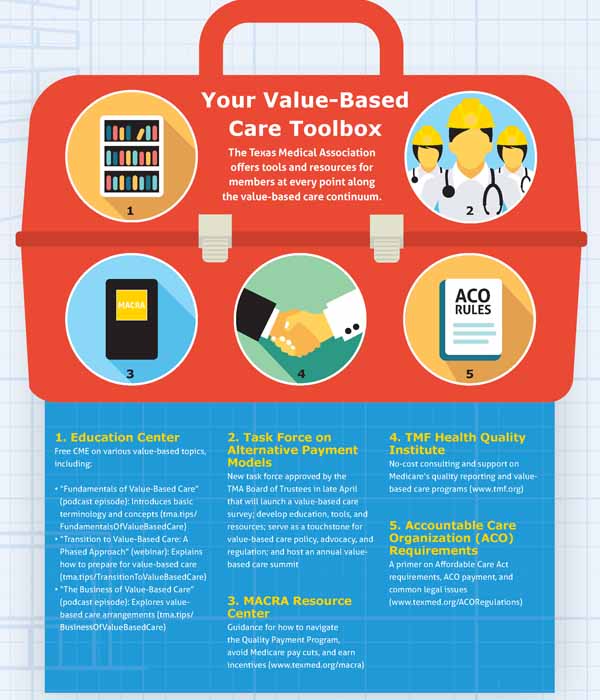
When family medicine physician Troy Fiesinger, MD, joined Village Medical, then Village Family Practice, in 2015, the Houston practice was at a crossroads.
What started as a small family practice had grown over the decades, and with that growth the traditional fee-for-service model offered diminishing returns around the time Dr. Fiesinger came on board. Village Medical needed to invest in additional resources – such as nurse care managers, clinical pharmacists, diabetes educators, and social workers – to improve patient outcomes. But stagnant payments left the practice unable to do so.
Here’s where value-based care enters the picture as a model that incentivizes and rewards physicians for looking at the big picture when it comes to care delivery. The Centers for Medicare & Medicaid Services (CMS) aims to transition all Medicare patients to value-based care arrangements by 2030. Meanwhile, commercial payers increasingly offer their own value-based contracts. (See “What’s New in Value-Based Care,” page 12.)
Yet, many physicians remain wary of or indifferent to value-based care. The vast majority of physicians rely on fee-for-service payment, salary, or some combination thereof, while just over a third draw at least some compensation from value-based care. (See “A Gradual Transition,” page 22.)
Moving away from fee-for-service requires taking on risk as well as hiring staff, launching new programs, and investing in data analysis. For solo and small practices especially, this proposition can be overwhelming or seem financially out of reach.
Still, practices of all stripes have made the switch successfully. According to the Bain U.S. Front Line of Healthcare Survey, 73% of physicians preferred fee-for-service payment models to alternatives in 2017. Three years later, 39% of primary care physicians were willing to consider value-based arrangements, according to the 2020 version of the same survey.
“These models offer more predictable cash flows and limited risk of profit pool compression because value-based savings will come from outside the primary care physician sphere,” according to a Bain analysis of the results. “[P]ayers are redoubling their efforts to educate [patients] and [physicians] on the value of moving down the care continuum where appropriate.”
And the ongoing COVID-19 pandemic may spur others to follow. Government shutdowns and pauses on elective procedures hit fee-for-service practices especially hard, severely curtailing their volume – and with it their revenue, according to a June 2020 brief published by the Margolis Center for Health Policy at Duke University. COVID also revealed stark health inequities and the role social drivers of health play in patient outcomes.
“I can’t say how much [it’s] a total game-changer,” Dr. Fiesinger said of his practice’s transition, adding that it can be done through partnerships versus going it alone.
Here’s a look at how practices of various sizes are making it work.
Case study 1: The four-physician practice
Around the same time Village Medical in Houston was shifting to value-based care, so too was North Hills Family Medicine, a four-physician practice with locations in Keller and North Richland Hills. The practice started by joining Catalyst Health Group, a clinically integrated network with more than 1,000 primary care physician members across Texas.
“We’ve always felt like fee-for-service is a poor [payment] model for primary care because we do so many things to help take care of the patient over and beyond the office visit,” said Gregory Fuller, MD, a physician at North Hills and a medical director at Catalyst.
Since joining Catalyst, the family medicine group has retained its autonomy as a small, independent practice, while gaining access to a suite of resources only affordable for much larger groups, he says.
This symbiotic relationship works because practices like North Hills provide Catalyst funding through a portion of the attribution payments payers disburse to physicians according to the number of patients under their care. In exchange, Catalyst uses that money to develop resources for its member practices, such as care coordination, data analytics, and an electronic referral system, that in turn help the physicians improve care.
Dr. Fuller, who also chairs the Texas Medical Association’s Council on Socioeconomics and is a past chair of TMA’s Council on Health Care Quality, says North Hills wouldn’t be able to participate in a value-based care arrangement without a partner like Catalyst.
“A small practice would have a lot of difficulty doing these things on their own just because of the cost of staff,” he said. “A lot of [these resources require] additional manpower, which small groups would have difficulty paying for.”
There are other motivations for North Hills. Dr. Fuller says the practice must meet certain quality measures to maintain its payments, but it carries no risk of financial penalties in the case of excess spending.
“The beauty [of this arrangement] is that currently there is no financial risk involved, and it doesn’t really affect our autonomy as a small group,” he said. “It just gave us an enhanced ability to take care of our patients and get the data to take care of patients better.”
Moving forward, Dr. Fuller expects his practice will take on more risk, which brings with it the possibility of more rewards – a step that can be untenable for small practices with thin profit margins and little room for error. Backed by Catalyst, however, Dr. Fuller and his partners have developed a higher risk tolerance.
Additionally, Dr. Fuller is hopeful Catalyst will help physicians move further along the value-based care continuum toward a prospective payment model, under which physicians are paid a set amount per member per month to keep their patient panel healthy. If this happens, North Hills would have a pool of money to fund patient care how it sees fit.
For example, the practice is currently incentivized to see patients in person, even if it is inconvenient for the patient. Under a prospective payment model, however, physicians could opt for telemedicine or nurse home care, where appropriate, without losing money.
“Value-based care gives us the opportunity to take care of the patient the way we need to take care of them,” he said.

Case study 2: From solo practice to large group
In the first of a series of steps toward value-based care, Laredo family medicine physician Luis Benavides, MD, transitioned from solo practice to a seven-physician group, Laredo Premier Healthcare, in 2016. The practice marshaled its shared resources to open a walk-in clinic, open six days a week from 7 am to 9 pm, that offered services such as x-rays and ultrasounds that not all its individual physician partners could provide on their own.
The group then formed Seven Flags ACO. Once it had developed some experience with the model, it joined South Texas Clinical Partners, a larger accountable care organization (ACO) participating in the Medicare Shared Savings Program. (See “Medicare Value-Based Care,” page 15.)
During its first year with South Texas Clinical Partners, Laredo Premier Healthcare saw neither shared savings nor shared losses. Since then, however, the practice has saved anywhere from 10.5% to 13% on its projected costs, producing meaningful rewards.
Earlier this year, Dr. Benavides and his six partners sold their practice to a venture capital company that helps practices serving senior and other vulnerable patients maximize value. As part of this larger entity, his practice has access to even more resources and leverage when negotiating with payers, technology vendors, and others. Dr. Benavides says these benefits have made it worth it for him to move away from independent practice.
“I don’t think it would be impossible [to participate in value-based care as a solo physician],” he said. “But … the savings are much easier to attain, and the measures are much easier to meet if you’re in a group.”
Dr. Benavides encourages physicians considering value-based care to seek out partners and arrangements in which their voices are heard, and their values are shared. He also cautions them to stay professional during business transitions, such as when an ACO must let go of a physician participant because he or she isn’t contributing enough to the shared savings.
In such cases, physicians can expect to thrive alongside their patients. As a result of their ACO membership, Dr. Benavides says he and his partners have grown more conscientious about preventive services like mammograms and vaccines. Although patients sometimes balk at their reminders, they also appreciate the benefits.
“They see us working at efforts to improve their overall health,” he said.
Case study 3: The very big practice
Back in Houston, instead of joining an outside ACO, Village Medical has chosen rapid expansion.
The 10-clinic practice transitioned to a value-based care model in 2015, participating in a series of ACO models and ultimately taking on full risk for its patient population starting in 2021. Under these arrangements, Village Medical has used its bonus payments to pay for the clinical programs and data analysis that Dr. Fiesinger says keep patients “home, happy, and healthy.”
This marked a watershed moment for the practice. Under fee-for-service, Dr. Fiesinger struggled to develop a cost-effective way to help patients with chronic medical conditions like chronic obstructive pulmonary disease, congestive heart failure, and diabetes. After doing everything he could in his office with limited resources, he says the best option often was to send these patients to a hospital that could connect them to a nurse care manager, a social worker, and a clinical pharmacist – a costly, inconvenient intervention he tried to avoid.
By participating in an ACO, however, his practice has been able to use bonus payments to hire its own nurse care managers, social workers, and clinical pharmacists to help its physicians closely manage their patients’ care, especially if payers are holding them responsible for the outcomes.
“For me, finally, the payment system aligns with what I always thought was the right thing to do ethically,” he said.
Now part of a much larger enterprise caring for more than 1.6 million patients, the Houston practice gained access to resources on a grander scale with the help of a value-based primary care services company that extracts, aggregates, and analyzes data from electronic health records, practice management systems, payer claims systems, and other sources.
Dr. Fiesinger says these kinds of tools, technology, and staffing support help him provide better care. For example, if a patient with high cholesterol to whom he has prescribed a statin isn’t filling his or her prescription, the system will flag it. Armed with this information, he can follow up with the patient to determine the root cause of the issue as well as a solution.
Dr. Fiesinger acknowledges that providing value-based care is hard work. Building the clinical team, clinical programs, patient education, and data collection processes required to thrive takes time. Practices, regardless of size, must standardize their approaches to care – from how to administer a Pap smear to how to manage chronic conditions – which takes compromise on the part of physicians and other health care professionals.
Still, he has “no reservations” about the model. He also believes any practice can shift from fee-for-service successfully.
“But there is strength in numbers,” he said.
Tex Med. 2022;118(6):20-24
July 2022 Texas Medicine Contents
Texas Medicine Main Page